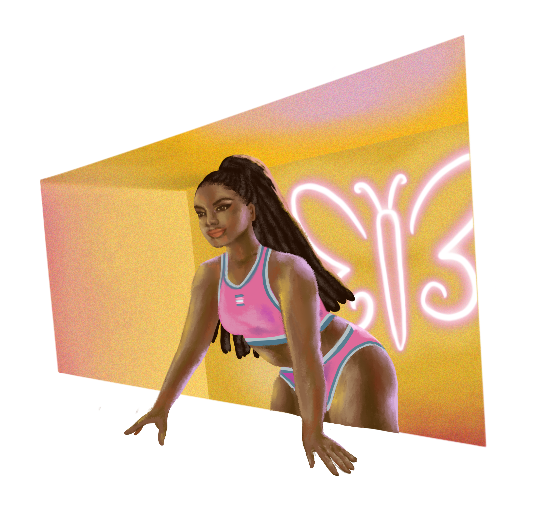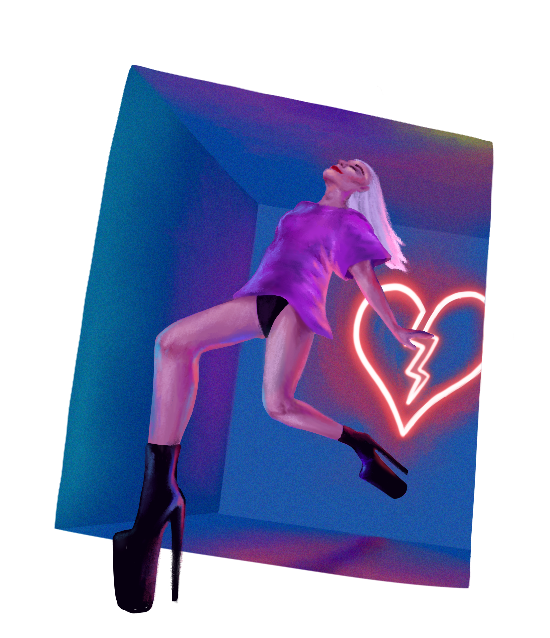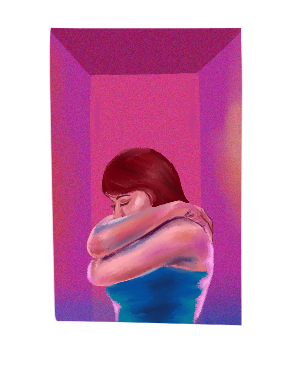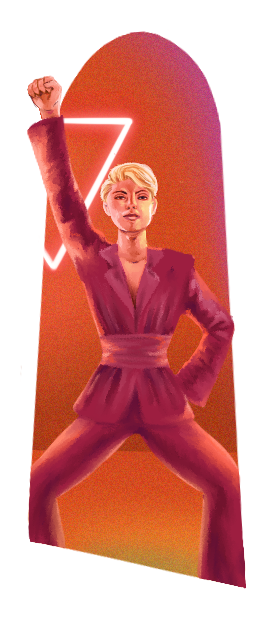For LGBTQ+ people, the Philippines’ sex education program is inadequate. Most modules are hetero-centered discussions that completely ignore LGBTQ+ identities. Although the Department of Education passed a policy last 2018 on a comprehensive sexual education program that seemed to cover all the bases, implementation in schools was still rocky. The belief that talking about sex will encourage more promiscuous behavior makes the topic still taboo for people.
But times are changing and people are becoming more sex-positive and more well-versed in how exactly multi-dimensional sex is. As more and more countries and cultures open their doors to LGBTQ+ people, we also have to face the fact that the community needs proper sex education too, especially for the young kids who are just coming to terms with their sexuality.
Although there’s a lot of online references, queer sex is extremely fetishized by people who don’t know any better so there’s a risk that search results will lean towards the porn type, which isn’t always helpful. So, to guide and inform the people who are just starting out or for those “veterans” who may need a refresher here’s a basic, gender-inclusive guide for safe LGBTQ+ sex.
Consent
Consent, the act of mutually agreeing to participate in any kind of sexual activity, should be the foundation of any sexual encounter. Even simple gestures like hand-holding or hugging should only be done after an enthusiastic “yes” from the receiver. Consent is a crucial step in sex but it doesn’t have to be a buzzkill. It can be as simple as asking “are you okay with this?” before taking anything further.
You also have to remember that getting consent to do this one specific thing doesn’t mean securing consent for any and all sexual activities until the end of time. Make sure to regularly check in with your partner. Aside from making them feel safe and respected, checking in at different stages will allow you to gauge if they are enjoying themselves.
Sexually Transmitted Infections (STI)
While sex is a pleasurable and magical thing, it does come with risks. Worldwide, STIs are a prevalent health problem, but in the Philippines, the most common ones are syphilis, human papillomavirus (HPV), herpes simplex virus (HSV) and HIV infections. According to the HIV/AIDS and ART Registry of the Philippines, youth aged 15-24 make up 32 percent of reported HIV cases.
Like sex talk, people approach conversations about STIs with shame, but most can be easily managed or treated with prescribed medication and antibiotics. It’s when symptoms are undiagnosed and untreated that STIs present a real problem. Some ways you can prevent an STI are frequent testing, vaccinations and correct use of condoms, gloves and dams, among others.
Now, to the task at hand. There is no single right way to have sex. The broad spectrum of gender identity means that individuals can decide what sex means for them and they can even choose not to have sex at all. But these safety precautions are recommended for any person having sex with another person, no matter the sexual and gender identity.
Penetrative sex
Penetrative intercourse is the act of inserting a body part or a toy inside someone’s vagina or anus. One of the best ways to ensure safer penetrative sex is to use a condom. Use a fresh condom for any sexual activity and with new sexual partners. Condoms also have expiry dates so check that too; it’s best not to use that one in your wallet. When you’re using toys like dildos, make sure that the condom is replaced before it’s used on anyone else. You can also use lube to reduce friction, lessening the risk of a condom breaking. Lastly, dispose of a condom properly by securing the base ring during removal, especially if there are bodily fluids, so it won’t come into contact with your partner.
For people who are into anal sex, It’s not always necessary to douche as the rectum is good at keeping poop from prematurely gushing out. But if flushing out the rectum with water can help you be more comfortable with poop-related concerns, go for it! It’s best to just use water as soaps may act as an irritant to sensitive skin and can even upset the rectum’s natural balance. For first-timers into anal play, invest in a good lubricant and bring your patience with you. Compared to the vagina, the anus doesn’t self-lubricate, so it takes a lot of relaxing and foreplay before you can begin without that much pain.
If you have penetrative sex using your hands, make sure that it has been washed with non-scented soap and water. Short fingernails are recommended in order to prevent cuts. Be careful of using fingers that have open wounds or scratches, especially if they’re not cleaned or sanitized. If you touch yourself, use another hand to touch your partner(s) or you can also go wash up before touching someone else.
Oral sex
One of the best ways to practice safe oral sex is to make sure that there’s a barrier between the mouth and the genitalia. For penises, condoms usually do the trick. For mouth-to-vulva or mouth-to-anus sex, dental dams, a thin and flexible sheet of latex, are recommended. They are big enough to cover the entire vaginal or anal area. Dental dams naturally stick to the body because of moisture so don’t press it too tightly against the skin to lessen friction. You also have to make sure to keep it in place to lessen the risk of contact.
Dental dams aren’t widely available in pharmacies and convenience stores but you can always try buying online or at an adult store. Another alternative for dental dams is latex underwear, most of which are available online. If you’re still having a hard time getting ahold of dental dams or latex underwear, cutting a condom into a sheet works too. As with penetrative sex, make sure to dispose of your dental dam, latex underwear and condom-turned-dam properly, making sure that no fluid gets into contact with the body.
Safe sex with toys
Toys are great for shaking things up and learning new things about yourself and your partner. Unlike vaginas, toys aren’t self-cleaning so one of your biggest concerns should be keeping a toy sanitized. Usually, toys come with their own set of cleaning instructions, which you simply have to follow. Aside from cleaning thoroughly (usually with antibacterial soap and warm water), one of the best rules to follow is to not share sex toys.
If you’re wondering about how to have safer sex, don’t be afraid to ask questions or to research. When you’re just starting out, there can be a lot of pressure or anxiety around it but remember this: Sex should be consensual, pleasurable and safe for everyone involved.
Art by Dana Calvo
Follow Preen on Facebook, Instagram, Twitter, YouTube, and Viber
Related stories:
This online pharmacy delivers sexual health products to your doorstep
Sex tech: The 2020 essential that prioritizes your pleasure
Sex ed museums: The cultural trip you need to try at least once
Follow these feminist subreddits to be more #woke, less sexist
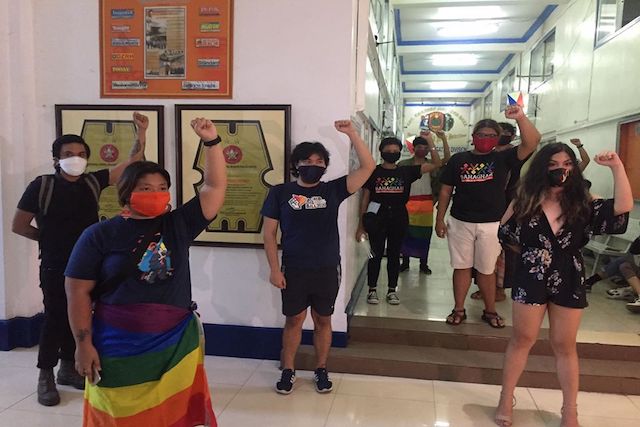
Pride is a protest and this morning, members of the LGBTQ+ community and its allies conducted a rally in Mendiola to celebrate Pride Month and to bring attention to calls ranging from #JunkTerrorBill to #NoToJeepneyPhaseout. Manila Police District (MPD) chief Brig. Gen. Rolly Miranda confirmed that a number of protesters were apprehended on Morayta Street. AlterMidya reports that 20 protesters were transported to the police station on UN Avenue, 10 from LGBTQ+ alliance Bahaghari, eight from Gabriela and two drivers.
UPDATE: The police nabbed at least 20 protesters, 10 from @Bahaghari_Natl, 8 from @gabrielaphils & 2 drivers. They are now being transported to the police station in UN Avenue. #FreePride20
— AlterMidya (@altermidya) June 26, 2020
An AlterMidya staff member said in a tweet that the MPD is claiming that a protester “sprayed something on an officer’s face” which prompted an arrest. However, the staff member adds that no such incident happened as evidenced by their live coverage of the event. In a video tweeted by GMA News, several officers in fatigue uniform are seen forcefully dragging a man out of a van to make their arrest.
Bago ang tensyon, nakapag-rally pa ang mga miyembro ng LGBTQ+ sa Mendiola. Aabot sa 30 tao ang naaresto ng mga pulis dahil sa paglabag umano sa mass gathering ngayong may GCQ sa Metro Manila. | via @Isa_Umali, @dzbb pic.twitter.com/y9MdyNggcI
— GMA News (@gmanews) June 26, 2020
Gabriela Women’s Party released a statement condemning the violent dispersal and mass arrest which reads, “We are enraged over this brazen showcase of police terror ironically against activists protesting fascism and tyranny, and against the looming enactment of the Anti-Terrorism Bill. We insist that there is now law prohibiting public assemblies during the implementation of the community quarantine. The constitutional right to peaceful assembly is not suspended even amid a health emergency.”
The group revealed that police “confiscated the keys and hijacked” protestors’ vehicles and “even manhandled Chriztina Madlangbayan, who is a legislative staff of Gabriela Rep. Arlene Brosas.” They further called for the immediate release of the detained protesters and launched the hashtag #FreePride20
https://www.facebook.com/GabrielaWomensParty/posts/1367246953485298
Bahaghari national spokesperson Rey Valmores-Salinas said on a live broadcast on the group’s Twitter account that the police have yet to inform them what violation against General Community Quarantine (GCQ) protocols they allegedly committed.
— Bahaghari #AchibDisBill (@Bahaghari_PH) June 26, 2020
Photo courtesy of Altermidya – People’s Alternative Media Network
Follow Preen on Facebook, Instagram, Twitter, YouTube, and Viber
Related Stories:
Pride is always a protest, now is a good time to remember it
This local org is pushing for safe spaces for this year’s Pride Month
Police arrested 7 protestors, not terrorists, in UP Cebu
Where’s compassion now? Two jeepney drivers still in jail a week after protesting for their livelihood
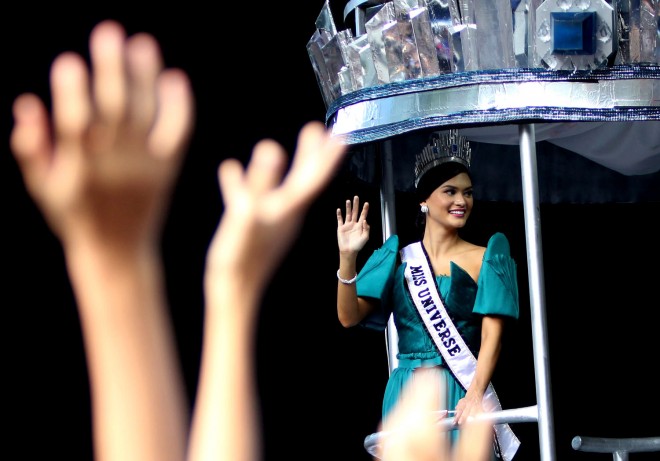
Miss Universe 2015 Pia Wurtzbach issued a statement on her Instagram welcoming Pride Month by writing “learning is always a two-way process…we listen as we understand each other’s points of view.”
Wurtzbach posted the statement recognizing the importance of a constant discourse to understand the concerns of the LGBTQ+ community. In the statement, Wurtzbach mentioned that “we may differ in opinions today, but our constant discourse will make our tomorrow better because we understand one another better.” She continued by saying “…our friends and family in the LGBTQIA+ community have the right to take up space in our society…that their voices should be heard, that we don’t invalidate trans women as women.”
This statement came two days after she spoke on a pageant themed online show about trans women joining beauty pageants like Miss Universe with four other beauty queens. The episode included Miss International Queen 2012 Kevin Balot’s statement saying that trans women are “asking too much” when they join traditional beauty pageants (i.e. pageants that only let cis women compete). While this received backlash from people online, Wurtzbach responded in the video by saying that “actually isa yang angle na hindi ko naisip kasi ako sa pagkakaalam ko Miss Universe allows so sakin if they allow sino ba naman tayo para magreklamo pa eh yung may-ari na pumapayag na.”
The beauty queen is known to be an LGBTQ+ ally and expressed her support for the legalization of same-sex marriage in the Philippines at a celebratory dinner during last year’s Pride Month.
Photo courtesy of Inquirer.net
Follow Preen on Facebook, Instagram, Twitter, YouTube, and Viber
Related stories:
Kevin Balot says trans women shouldn’t join “traditional” beauty pageants, huh?
Beauty pageants may be empowering—but is that enough when they enable abuse, too?
A university pageant with straight men who act gay? Homophobic
Picture this: Pia Wurtzbach as a Marvel superhero
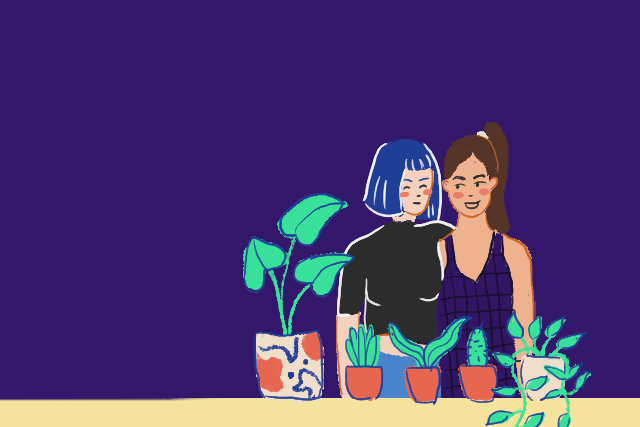
When I think about the word safe space, it’s people that come to mind, not places. My safe space is with my friends and I like to think that I can find it with my family, too, soon. I’m lucky it never crossed my mind that coming out to my family would be met with hostility.
Unfortunately, that’s not the case for everyone. Athlete Jason Collins once said, “Openness may not completely disarm prejudice, but it’s a good place to start.” I hope that by trying my best to take part in conversations within and about the LGBTQ+ community, it can encourage others to do so as well. Each year, especially during Pride Month, I try to listen more closely to the folks who still badly need physical and digital safe spaces and whose experiences are very different from mine.
When Bea and Casey started online safe haven Queerspace PH, their initial plan was to “lessen aggressive content to engulf the community with positive and empowering messages that are not overwhelming.” But with the “flaws of a silently destructive system more visible than ever,” the team was reminded that it’s good to show that you’re angry too. I had a chat with Bea and Casey on how safe spaces aren’t silent.
How have you been personally celebrating Pride so far? Any activities our readers might want to try?
So what we’ve been doing to celebrate Pride is just pouring our work into our content. We’ve been attending webinars from small LGBTQ+ organizations and learning more about the community and reflecting what Pride means to us especially now in the midst of the pandemic. We recommend everyone to do the same and attend fun ones too, like vogueing classes from the House of Mizrahi PH and online drag shows!
While doing some research for our Pride stories, we came across a Reddit post where you were gathering stories from the LGBTQ community who didn’t feel safe while quarantining with their families. What is Queerspace and what roles both of you play on its team?
Queerspace is an online safe space for LGBTQ+ Filipinos. We want to provide a place where people can express their identities, engage in conversations and be empowered together.
We’re a team of 2 and we do pretty much everything! Everything you see in Queerspace is curated and created by us!
What’s the story behind why Queerspace PH was formed and how it started?
We wanted to build an online presence for the queer community in the Philippines that is focused on empowering content that will make them feel like they’re valid and not alone. There are also many LGBTQ+ organizations that are focused on lobbying for LGBTQ policies, who are already doing excellent in this sector. Thus, we wanted to focus more on the presence of the LGBTQ+ community online.
Initially, we wanted to do a physical space. We decided to not wait anymore and launch it as a digital space because we think it’s important to have one now during the pandemic. Many queer Filipinos are vulnerable now because some of them are not in places where it is safe to be themselves. At the same time, inequality has been heightened and more evident now, especially in workplaces and medical institutions.
Safe space is a universal and, at the same time, a very personal concept. What does the term mean for you and how does one go about creating one for themself and for others?
We acknowledge that safe spaces can have different meanings for different people. For us, a safe space is where someone can be free to be themselves and belong in a community. Many people have criticisms over the word, like how they think it stifles freedom of speech, shelters people or keeps them in a bubble.
We actually think it’s quite the opposite. We think safe spaces are created because the public excludes us from the conversation. Our version of a safe space is not only talking about happy things, it is where a community empathizes and empowers one another. It is not about limiting speech, but being compassionate and inclusive in conversations.
We think it’s quite similar how people should create safe spaces for themselves and others—it’s always about being compassionate and having a deep understanding of your struggles or other people’s.
On your Instagram page, there was a post about how the word queer is also a verb that means to disrupt something. What does this mean? How is it connected to attaining inner peace?
We actually just learned about this! Queering is a verb used for challenging heteronormativity in places, literature and just about everything. It makes people think outside of gender norms and see that things can be seen differently when you include other identities in the picture. Like for example, growing up, we were taught that there are “boy clothes” and “girl clothes”. To queer this thought is to ask, “what does my sex have to do with the colors pink and blue?” or “why can’t men wear skirts?”
While we’re a safe space and we want to provide a peaceful environment for the community, we just can’t simply put out content for the sake of being positive. Safe spaces are political. There will be no peace if we keep getting excluded outside of our safe space. These conversations are also important to empower and validate identities and let people know nothing’s wrong with them, the world just has a lot of queering to do!
What are some digital and physical queer spaces that you would recommend to members of the LGBTQ+ in the Philippines?
An organization called MapBeks identifies safe physical spaces! You can check out their LGBT Safe Spaces Map. They map out LGBT-friendly businesses such as cafes, bars, support groups, health services, and more. They even show which city or province has an Anti-Discrimination ordinance.
Like what we said earlier, a number of LGBTQ+ organizations are currently using digital spaces to hold webinars, kamustahans, and other similar events for the members of our community, including allies! These organizations include Metro Manila Pride, UP Babaylan, Open Table Metropolitan Community Church, The Society of Transsexual Women of the Philippines (STRAP), Philippine Anti-Discrimination Alliance of Youth Leaders (PANTAY), and Mindanao Pride!
How close or how far are we in making our country a safe space?
The Philippines may be safer than other countries as we do not have laws that prohibit being part of the LGBTQIA+. However, the Philippines still has a long way to go. Everyone in the community will agree. There are members who experience discrimination because of how they present their SOGIE (Sexual Orientation and Gender Identity and Expression). There are people who believe that we cannot have the same rights as heterosexuals because of heteronormative thinking.
The current pandemic has also exposed the vulnerability of our members. We recently talked to members of the AIDS Society of the Philippines and STRAP who are working together to fundraise for displaced trans women in the country. Our trans sisters lost their livelihood due to the suspension of work and restrictions in social mobility during the quarantine.
As long as these are not addressed and our society is not genderblind, we cannot confidently say that our country is a safe space.
We’d also like to clarify that safe spaces aren’t just for the LGBTQ+ community. Safe spaces are intersectional. Minority groups such as our indigenous people, urban and rural poor, the working class, farmers and fisherfolk, and other underrepresented populations must be included in determining whether our country provides safe spaces for them.
What can we look forward to from Queerspace PH?
We have lots of queer content coming your way! While we are still restricted to go around and meet people, we will continue to be here for our online LGBTQ+ community. We just started last month so we think it’s a great time to explore, collaborate with other organizations, and feature more queer Filipinos digitally. We’re still getting to know our audience and trying to reach more. For now, we’re just doing our best to help the community cope with our current situation and finding different ways to engage with them.
Art by Dana Calvo
Follow Preen on Facebook, Instagram, Twitter, YouTube, and Viber
Related Stories:
Meet the young Filipina CEO of Developh, a non-profit fighting injustice through tech
Art is visible dissent for the poets of this Anti-Terror Bill collection
Mental health is political for this young Filipina and her global youth network
BJ Pascual and Vince Uy tell us why living our best queer lives is about social justice
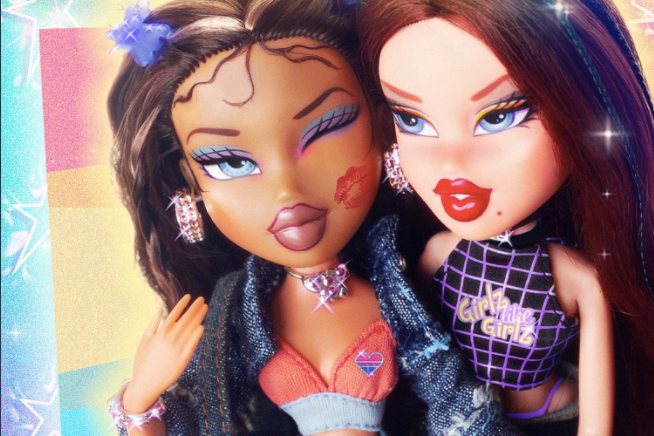
More than being “the girls with a passion for fashion,” Bratz may just be our next queer icons. On Jun. 23, Bratz posted a photo of Nevra and Roxxi holding hands with the caption “steppin’ out and coming out!”—another win for the gays.
Steppin’ out and coming out! Nevra & Roxxi are sharing their super stylin’ pride! Happy Pride Month from the whole Bratz Pack ?️??? #pride #pridemonth #bratz pic.twitter.com/QX5cbMnbCU
— Bratz (@Bratz) June 22, 2020
While the famous doll brand did not disclose any further details regarding the sexualities of the two characters, many people praised the brand for tweeting in celebration of Pride month and “bi visibility.”
In the photo, we could see Roxxi wearing a printed shirt that says “girlz like girlz” while we see Nevra wearing a heart-shaped pin with the design of the bi flag. In the second photo, Nevra has a kiss mark on her cheek which looks like it came from Roxxi—the kiss mark is the same shade as her lipstick. While we can’t make our assumptions yet on whether these two are an official couple, they sure do look cute together.
The Bratz dolls rolled out during the early 2000s and were quickly loved by young girls from all over the world. Their first squad consisted of four dolls that had different hair colors and skin tones that a company representative once called “ethnically ambiguous.” The dolls known for their big eyes, luscious lips and heavy makeup grew to be a big hit, but Bratz did receive criticism for perpetuating racial stereotypes and sexualizing young girls. Despite this, some still gave the brand credit for having dolls that didn’t all have blond hair and blue eyes, which was also true for their other media adaptations, like the Bratz movies and TV show.
Fast forward to the present, Bratz continues to welcome diversity and inclusivity. On May 31, Bratz issued a statement calling to sign the Justice for George Floyd petition and said “Bratz has always been and will always be about diversity and inclusivity…we can’t call ourselves inclusive while staying silent about these social injustices right in front of us.” For a brand with a huge platform and influence (remember the #BratzDollChallenge last year?), it’s good to see them work towards more inclusivity and representation. While we’re not sure yet if Nevra and Roxxi are canonically bi or lesbian, it’s safe to say that it’s not completely out of the picture yet.
Photo courtesy of Bratz’s official Twitter account
Follow Preen on Facebook, Instagram, Twitter, YouTube, and Viber
Related Stories:
#BratzDollChallenge: Is the Bratz era back?
Peppa Pig is now a gay icon—here are the unlikely characters before her
The Lil’ Gay Shop and how it explores the definition of queer art
Set your route on “Pride March at Home”; to help LGBTQ+ folks affected by COVID-19
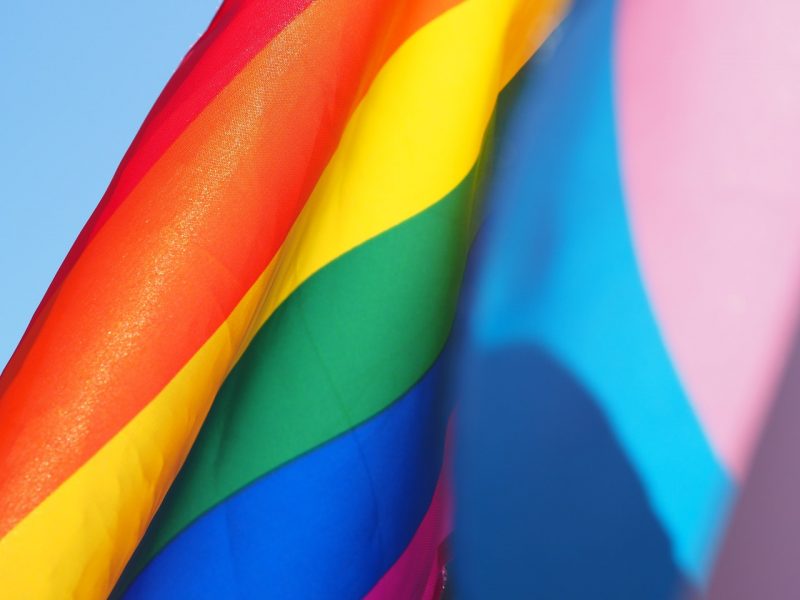
The AIDS Society of the Philippines in partnership with The Society of Transsexual Women of the Philippines (STRAP) are still accepting donations to help trans women in need during the pandemic.
Originally posted on their social media platforms last May, the donation drive aims to help out trans women who are having a difficult time generating income during the quarantine. The cash donations will also be used to help fund gender affirming medication for women who are having trouble accessing it.
An update posted on June 5 said that they have so far raised P90,000 from generous donors. They are already helping out their intial list of beneficiaries with the current amount. Still, the organization is looking for more donors in order to help more trans women disenfranchised by the pandemic. Aside from cash donations, in-kind donations are accepted as well.
The coronavirus pandemic has worsened trans healthcare globally as reported by Vice. All over the world, trans people are experiencing surgical deferrals and suspensions of hormone treatment services brought about by lockdown restrictions. In the US, the federal government recently removed gender identity as grounds for discrimination in healthcare meaning that hospitals will be able to refuse to provide services to trans people even in the midst of a pandemic. In Panama, the government has been implementing gender-based quarantine so trans people who are closeted or haven’t updated their gender markers are faced with a healthcare and legal hurdle. England is also expecting a bottleneck once operations resume for services such as hormone treatment or therapy, as waiting time for services has been pushed back by the pandemic. Here in the Philippines, trans people are losing income while in lockdown because many of them work in informal or nonessential industries.
Photo by Cecilie Johnsen on Unsplash
Follow Preen on Facebook, Instagram, Twitter, YouTube, and Viber
Related stories:
VP Leni Robredo’s gadgets donation drive is here to help K-12 distance learners
Help out unemployed jeepney drivers with this donation drive
Don’t forget: Marginalized women and girls need sanitary pad donations too
How to donate to the Golden Gays during the enhanced community quarantine
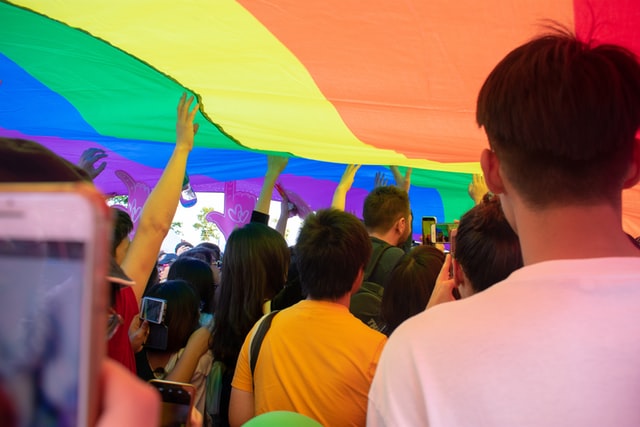
A year ago, we were worried about how we’ll get to where Metro Manila Pride is going to be held. In 2020, our worries are now along the lines of “When can I get an IRL hug from my friends?” and “Are the places where my friends are quarantining safe spaces for them?” The LGBTQ+ community and its allies have been thinking of different ways we could all stay connected and help each other out. Non-profit Pride@Tech is one of the many organizations creating and dedicating platforms to support this cause.
Pride@Tech is an initiative started by Google, Facebook, Globe, GCash, IBM, Analog Labs and Propel Manila. Collaborating with Metro Manila Pride and MindNation, the group is organizing a virtual Pride March on June 27 at 3:00 p.m. Proceeds from the event will go to LGBTQ+ communities affected by the pandemic.
Interested in joining? Here’s how you can get in on the fun:
– Visit marchforpride.com and set your virtual march route. For safety purposes, it’s best to keep your address private.
– Choose a color from the rainbow for your route.
– Submit your march along with a caption and the hashtags #Recreate #Pride2020 #PrideMarchFromHome.
– Pledge your support by either donating or sharing about it online.
In their video announcement, the group stated that just because we’re stuck at home doesn’t mean we can’t come together for our rights. We can’t argue with that, can we? So, start stretching because we’re going to do some cardio for a cause.
Photo courtesy of Unsplash
Follow Preen on Facebook, Instagram, Twitter, YouTube, and Viber
Related Stories:
Pride is always a protest, now is a good time to remember it
This local org is pushing for safe spaces for this year’s Pride Month
Read ’em and weep: The free, queer books that will prep you for Pride month
On lockdown? This Pride Month online concert lets you celebrate at home
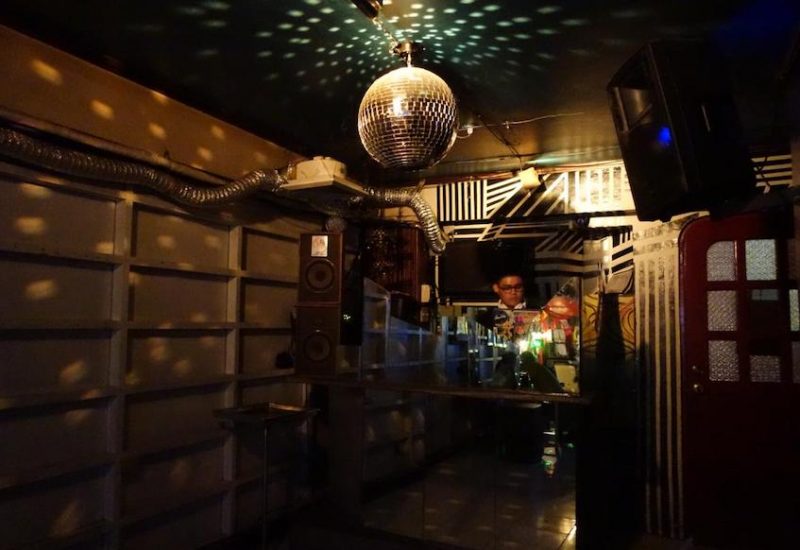
ICYMI, beloved queer safe space TodayxFuture has announced that it’s closing its doors.
[READ: RIP TodayxFuture, the queer safe space where all the kids could cry-dance]
While it’s a sad time for everyone who’ve called the Cubao club home, I have some good news: If you want to own a keepsake from Future, just head over to @txfthesale on Instagram.
“All proceeds go to building a new Future. Please comment on photo to reserve or place a bid,” the account’s bio states.
As of writing, there are currently 31 items up for auction—including the iconic red neon signage that used to frame the bar. (Starting bid for that is 15000, and the account notes that it’s “currently out of order [and] needs fixing.”)
The auction ends on Wednesday, @txfthesale shared to Preen.ph. They also said that they’ll be uploading more items soon.
Header photo courtesy of Tammy David
Follow Preen on Facebook, Instagram, Twitter, YouTube, and Viber
Related Stories:
Celebrate Pride month with this screening of ‘Ang Huling Cha-Cha ni Anita’
Pride is always a protest, now is a good time to remember it
This local org is pushing for safe spaces for this year’s Pride Month
Read ’em and weep: The free, queer books that will prep you for Pride month
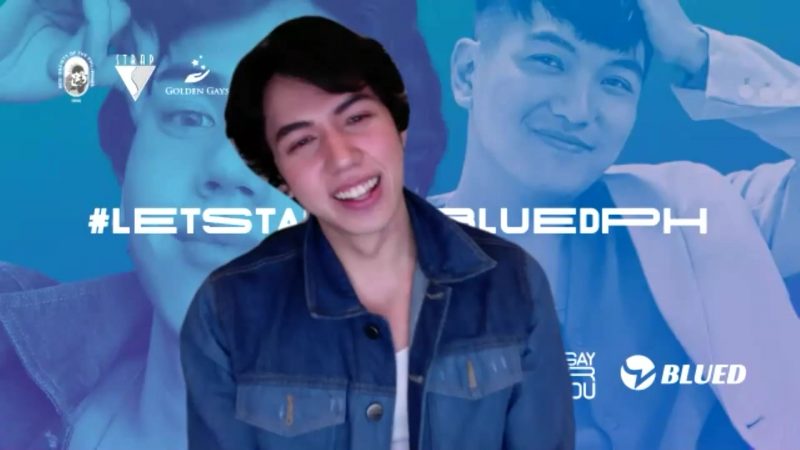
We live in a world where being alive is political and stating that everybody deserves a good quality of life is sometimes met with disagreement. It’s frustrating to say the least but knowing that you’re not alone in wanting to change this and hearing about the different steps people are taking to make the world a safer place is a big comfort. For the LGBTQ+ community, Pride month is a time to better amplify initiatives connected to LGBTQ+ welfare and rights.
In 2020, a growing number of people are dedicating their energy to provide more platforms for the LGBTQ. Take gay social app Blued for example. Recently, Blued Philippines launched a campaign that aims to provide insightful conversations where Filipino gay men could engage in and learn from on their platform. Blued Philippines’ country marketing manager Evan Tan said, “#Let’sTalkOnBluedPH is a continuation of our mission to inspire, educate, and empower Filipino gay men to live their best lives not just for themselves, but for the society at large.”
The community discussions series will be aired live via the Blued app and led by key LGBTQ+ opinion leaders. For its media launch on June 10 via Zoom, Blued invited Filipino drag queen Vinas Deluxe, creative director Vince Uy, photographer BJ Pascual and representatives from their beneficiary organizations. We got a taste of the online chikahan with event host Mela Habijan and some of our favorite LGBTQ+ creatives. Here’s a peek at the type of conversations you could be having on Blued’s live chats.
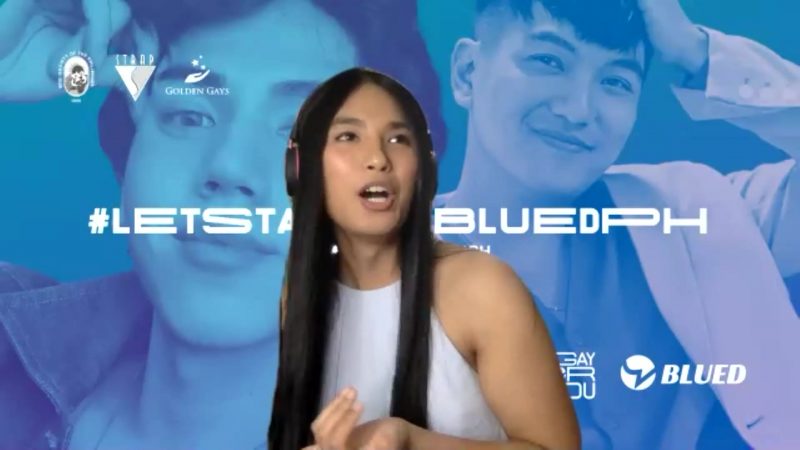
A still of Mela Habijan on #LetsTalkOnBluedPH’s Zoom launch
Mela: Very common in the gay community ang ma-shame ka because you’re effem(inate) or you’re [a] bottom, ‘di ba? Kayo ba, Vince and BJ, na-femme shame na ba kayo?
BJ: Ako a lot. Parang it’s been a whole journey dito sa shaming na ‘to. Kasi in the beginning, syempre starting Instagram, people would only see me through Instagram. I mean, yung mga people na hindi ako kilala in real life. So it’s just the picture that they see. And when they see me talk—biglang may video—parang nagugulat sila. Parang “Oh my god, yung itsura mo ganyan tapos yung boses mo, boses kiki ka.” Ganyan. Kahit naman before pa ng social media age, I would get a lot of shame for my voice. For having a gay voice. It’s always been a point of struggle for me. There was a time na kinahihiya ko sya. I wouldn’t post videos talaga. Ngayon naman I post yung mga pa-yummy na pictures—
Mela: Which I like ha. Ang sarap-sarap mo ngayon, Tita BJ.
BJ: So kunwari pinopost na sya ng mga thirst account. Nirerepost yung mga pictures ko. Syempre magcocomment yung mga tao doon. “Eh, malambot naman yan in real life.” Ganyan. So parang, paano ba dapat magpose? Dapat ba kapag nakahubad ako, nakakembot din ako? So it’s hard. Parang now naman, I’ve recently been masc-shamed naman. This whole quarantine, syempre nakapambahay lang naman ako all the time sa mga [IG] stories. Lagi akong naka-gym outfit—yun lang kasi yung ginagawa ko dito sa bahay since walang work. I got a tweet na basically masc-shaming. “Oh ngayon, pa-masc masc ka na ngayon. Kinakahiya mo na yung pagiging effem” blah blah. Parang ako, hindi naman. Hindi lang ako makapag-outfit ngayon kasi wala naman aawrahan ngayon.
Mela: So, na-femme shame ka, na-masc shame ka. Saan ka lumugar?
BJ: [Laughs] Wala. Kung ano lang feel ko. You don’t have to be pressured by anyone to be a certain way. It doesn’t matter what other people say. Madali siyang sabihin, alam ko. Syempre nakaka-affect, but it’s a journey to self-acceptance. Yung coming-out, parang maraming stages yan eh. For me, when I came out parang sobrang out ko agad. I was super proud of it and then I got comments na parang, “Masyado ka naman atang out there.” At some point, nag-hold back rin ako. It took a while for me to realize na okay lang.
Mela: Do you also share that, Vince? It doesn’t matter what other people think?
Vince: Ako, I’m so over it. Obviously ako ibang generation than Beej. So, medyo malayo ang generation gap namin.
Mela: Hindi halata!
Vince: Ako nung time ko, it was also hard. Because when I came out, I had no notion that gay men can be masculine.
Mela: Oh, talaga?
Vince: And I remember na during my first group eyeball,—
Mela: Ang taray ng group eyeball!
Vince: Oo! Ganun. Wala talaga. Wala akong community noon. That’s why now I appreciate this, what Blued is doing, because you are creating a community. Kasi I had none. I had no one. So, imagine me stepping into a restaurant. Pagpasok ko, sabi ko, “Oh my god. Lahat kayo guys.” Tapos sabi nila, “Yeah. Eh, bakla kami so we’re guys.” Ako my notion was, pag bakla ka—yung concept mo of how it is was how gayness was portrayed on TV. Like parlorista, ganun yung notion ko. So I was so afraid to come out. Kasi it made me question na, “Ganun ba ako?” And then I realized na if I’m masculine or feminine, that’s me. It took me a while to get there. I know how important it is to have a support system that will really encourage you or inform you of these things. Kasi ako, I didn’t have that back then eh.
Mela: Ang sabi nga ni Jebby ngayon [through chat] eh, “I think it roots sa fact na ang toxic talaga ng masculinity na if you act within the boundaries of what society thinks a female is, mahina ka na. Malamya ka na. Sobrang unfair to women and their strength.”
Vince: True. Exactly.
Mela: Some men in the gay community think that being gay is at the top-most level of the LGBTQIA+ community. Yan pa yan. Kaya maraming mga gay men ang phobic. Phobic sa lesbiyana. Phobic sa transwomen. Phobic sa lahat.
BJ: Totoo.
Mela: Kayo, anong stand niyo dito?
BJ: The sad part is yung nagpeperpetuate rin ng ganitong notion is tayo-tayo lang din. If you look at yung comments sa section sa mga thirst accounts, grabe yung effem-shaming dun. Dun ako nagrereact eh. Usually kasi dinededma ko na lang because I get it so much. But pag yung mga comments sa public forum na parang may picture ko about my body blah blah blah and then yung comment “Eh, malambot naman yan in real life.” Sasagutin ko talaga sya. “Eh, ano ngayon?” Ganun. I react differently to these things. I choose my battles syempre. If it’s someone I know, I will correct them. Pag yung mga trolls lang na accounts talaga, di ko sila pinapansin.
Mela: Vince, have you corrected someone, especially kung gay man siya? Have you ever corrected him kasi ang baba ng tingin nya sa lesbiyana, sa trans?
Vince: Yes!
Mela: What happened?
Vince: Kasi, parang I see to it. Kasi ako, I always say that you have to start within your circle. And it’s important to have these conversations with your friends. Like ako, ang dami kong gay friends. Kwarenta yata kaming magbabarkada na mga bakla.
Mela: Isang section!
Vince: Isang class! Ganun. Alam mo yun? You have to initiate these conversations and you have to correct them with the right term. Kasi sa akin, I think it’s very important right now that we constantly educate ourselves. Ako mismo, I’m still educating myself. Kasi constant urge yan to better yourself. May instance na we were at a PR and meron kaming barkada na trans. Nung naglakad sya, parang sinabi sa kanya, “Dito po, sir.” So yung mga barkada ko tumawa. Talagang dinagukan ko talaga sila. Actually, bago ko sila dagukan, kinorek ko muna si guard. Sabi ko, “Ma’am po siya. Hindi sir.” Tapos kinausap ko yung mga friends ko na, “Guys, ano ba! Hindi ito joke.” Alam mo yun? May instances lang na parang you have to consider reminding everyone din within your circle. Even sa family, constantly reminding them na these are the terminologies. Ganun.
We are rarely given the chance to have intimate conversations with industry leaders on topics that are pressing but sometimes avoided even within the LGBTQ community. Of course, we don’t have to wait for opportunities like these to come up before we push ourselves to speak up. Still, a little inspiration can come a long way. The bi-monthly sessions are going to be held until November this year. The topics will range from fighting social injustice to improving home cooking.
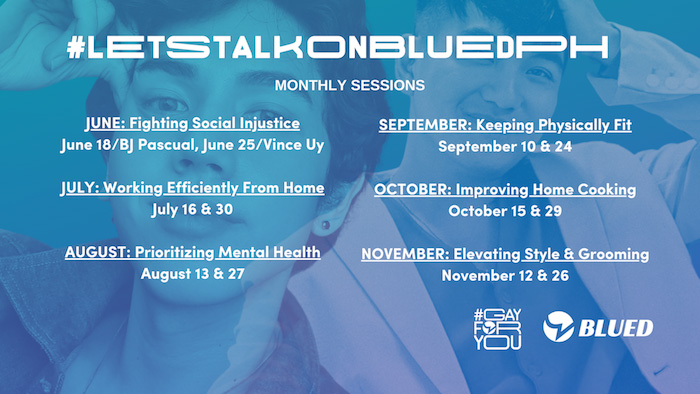
Tan shared how #LetsTalkOnBluedPH aims to go beyond covering queer lifestyle. To champion and echo advocacies through the app, they partnered with Home for the Golden Gays (HGG), the AIDS Society of the Philippines (ASP), and the Society of Transsexual Women of the Philippines (STRAP). “Since pumasok nga yung pandemic, yung quarantine, we realized na we can give a bigger purpose to this campaign, which is helping members of the LGBT community who have been affected,” Tan added.
The seniors of the drag community are some of the worst hit financially during the quarantine. HGG’s president Mon Busa narrates, “Yung mga pinagkakakitaan naming araw-araw at yung mga oportunidad para kumita, lahat nawala yun. Kasi nga lockdown completely, hindi kami makalabas. Walang transportation, bawal ang mga seniors bumaba. Kaya talagang napakahirap para sa amin na suportahan ang mga pangangailangan namin sa araw-araw.”
Program officer of ASP Vashti Rebong revealed that they have been working hand-in-hand with STRAP to extend help to transgender women who have been feeling disenfranchised as well. “Ang pinaka-immediate na kaya nating matulungan ay ang economic concerns nila. That’s why nagkaroon kami ng fundraising initiative in partnership with STRAP, to raise funds for our sisters. And we will be giving out cash aid to them,” said Rebong.
Aside from their initial donations, Tan said that Blued will be asking their featured opinion leaders to donate directly to the three organizations which are Home for the Golden Gays (HGG), the AIDS Society of the Philippines (ASP) and the Society of Transsexual Women of the Philippines (STRAP). Join in on the conversations and give these LGBTQ+ groups some love.
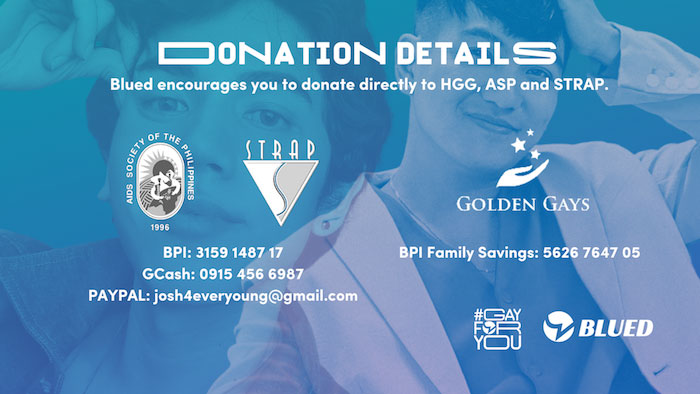
Photo courtesy of Blued Philippines
Follow Preen on Facebook, Instagram, Twitter, YouTube, and Viber
Related Stories:
Power to the parlorista! We kiki’d about Zsazsa Zaturnnah with her creator
This local org is pushing for safe spaces for this year’s Pride Month
Read ’em and weep: The free, queer books that will prep you for Pride month
Celebrate Pride month with this screening of ‘Ang Huling Cha-Cha ni Anita’
After almost 12 years, TodayXFuture is ringing its last call. The club in Cubao, known as an underground safe space for the LGBTQ+ community, posted the announcement of its closure with a love letter on their Instagram page.
“After long days and nights of deliberation, wrestling options and way too much alcohol to cushion the emotion, we are left with the decision to say farewell,” reads the letter. It’s not all bad news; its sister club, Futur:st in Poblacion, will remain open, and they’ll be “throwing one last hurrah” with an online Pride celebration on Jun. 27.
Still, its closure feels like a sucker punch for all regulars who’ve found their chosen families there. TodayxFuture, or TxF, or just Future, was more than just its physical location; crying out to Carly Rae at its sweaty dance parties was like coming home, or coming to church. I didn’t even realize how many people I knew who found refuge there until the bomb dropped today, when my WhatsApp groups started lighting up with goodbyes. “Dear TxF, thank you for teaching me how to dance like no one’s watching,” Tricia, our designer, wrote. Nimu Muallam, our creative director, sent a slightly blurry video taken from the club at 3 a.m., Ariana Grande’s “Thank U, Next” blaring through the speakers and shooting through the iconic red light.
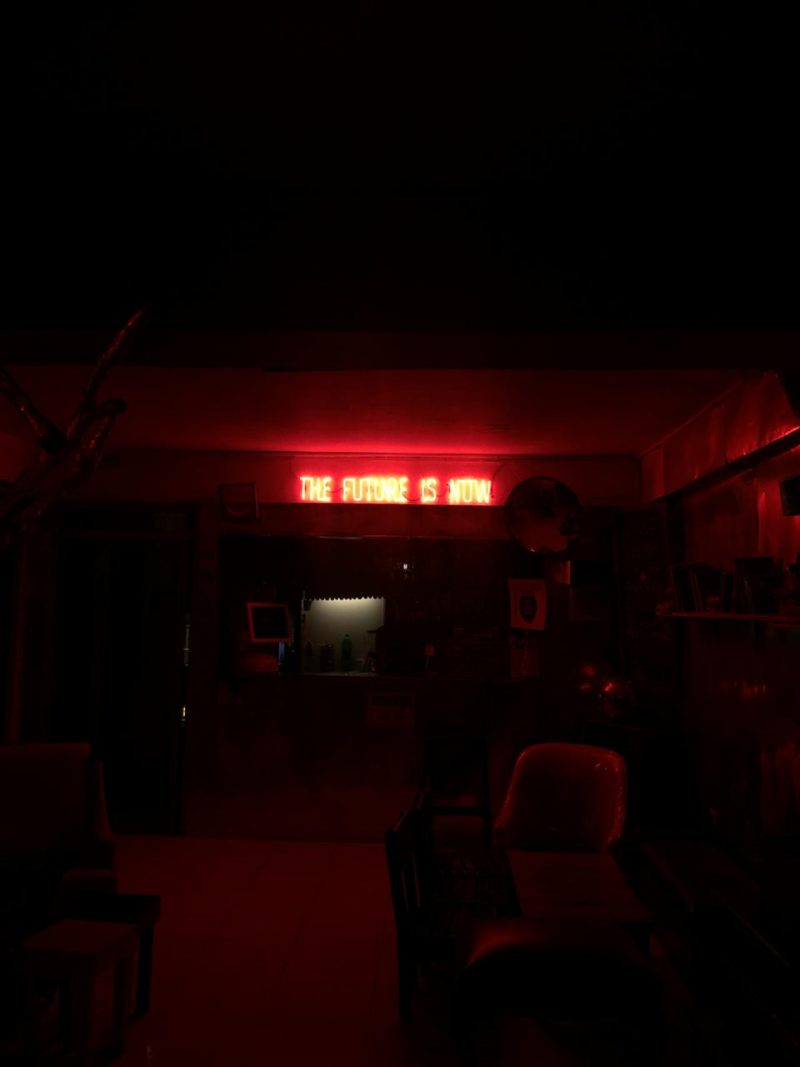
TxF was a community, so we reached out to people who found communion there.
“Around 2012, the entire stretch of General Malvar Street in Cubao would be empty and dark, save for a small glowing corner hidden between two pawnshops. It was the size of a bunker, and served a similar function. We sat on chairs scattered in the middle of the street, and our noise would echo up the unfinished buildings. I think places attract similar people, and Future attracted people just like it. It was a place that shouldn’t even have been there, but it was, and you only found if you knew where to look.” – Joseph Pascual, photographer
“I can’t find the words for how much it hurts me to even type the words, but it hurts, because that little dive bar in Cubao meant so much to me, and the time I spent there—especially from 2014 to 2016—played a massive part in shaping who I am now.
Future is where I ran to after every heartbreak to dance my feelings away to Robyn. Future is where I was the night before the day I was supposed to fly to Berlin to be with my ex — they kept the drinks coming, no one let me pay for anything, and I almost missed my flight to Boracay the next morning. Future is where Bobby and Karlo taught me how to love techno, so technically, Future is the reason I’m part of @unknwn.mnl. Future is where I met Bobby, so technically, Future is the reason I first set foot in Berlin. Future is where they cut the music at midnight to sing you “Happy Birthday,” then kick the party back into gear by playing your favourite song. Future is where they put you behind the decks even though you have no idea what you’re doing—I’ve played hip hop, house, techno, disco, indie, and tons of pop there because Future is a place for everyone.
I’m not crying for the space. (And believe me, I have been crying since I read the announcement.) I’m crying for the memories. For the friendships I made there. For the stories we told while seated on the sidewalk. For all the laughter. For the songs I played behind the DJ booth. For the songs I sang along to from my spot in front of it. For the small handful of straight boys that I kissed there, which, if you know Future’s demographics, is a small miracle. For the way that little corner of Quezon City made me feel. For that moment when I realised that it was home and that I could be who I wanted there.
I’m crying because it was home, and home is so hard to find, and I am heartbroken to be losing another. Future made me feel like it was okay to be every strange thing I was. I’m crying because I will miss it so much. I’m crying because I’m so grateful to have had it in my life.
I hope you find a Future of your own, like I did. I hope it changes your life, too. I’m staying in bed today. I need a hug. This is all too much. Too much.” – Regina Belmonte
View this post on Instagram
“I will definitely miss Future. I will miss hosting my monthly paandar—from Beerhouse Disco to Disco Prommm to Danchalant to Party Lang Cheerhouse to Kalat to my sentimental favorite…effortLast. I will miss doing the posters with my good friends Nimu Muallam (whom I’ve been asking to spin) and Paolo Abad (who eventually started spinning for some of my nights). I will miss playing (or making tambay) for Tuesday Mood—hosted by my other good friend Darryl Recina.
I will miss the food—my fave is the bolognese spaghetti. I had this phase where I would take some out before going home. I’d eat it while watching Lady Bird again and again before going to sleep. I will miss the rum cokes, the gin with whatever.
I will miss Palafox and the other guys who worked there. I was one of the privileged few who can make palista our bills. It was practically like visiting your relatives’ house in Cubao. It really felt like family, and I was the resident Uncle of Future.” – Melvin Mojica, stylist and known to many as Future’s Mang Melvin

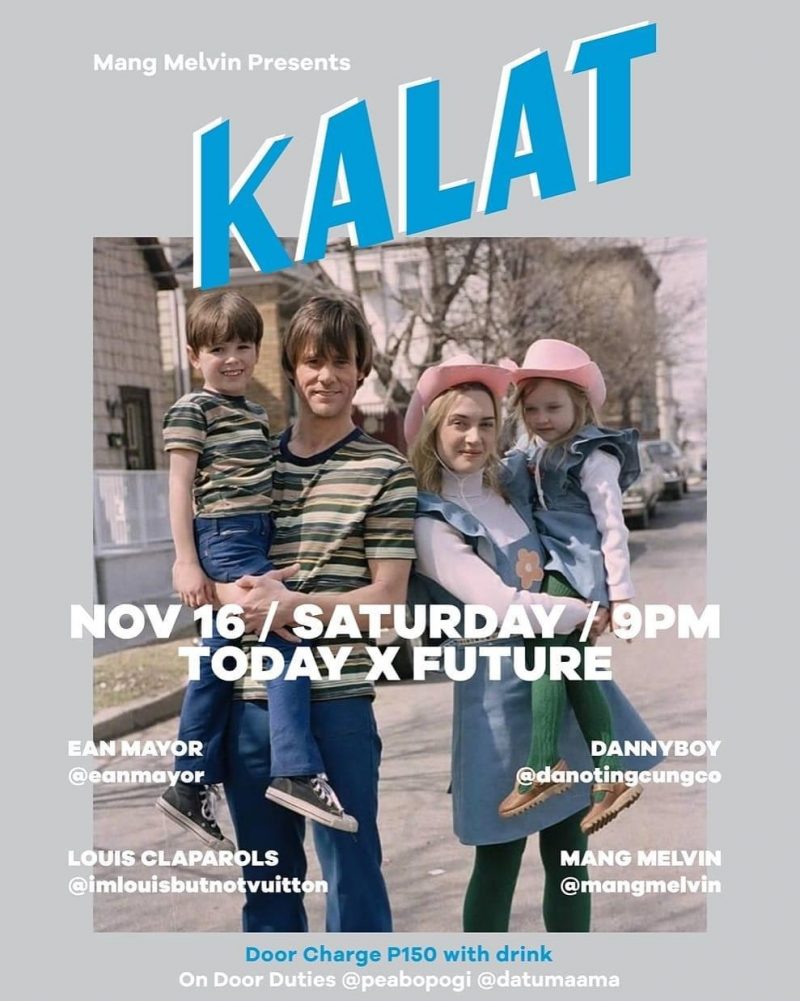
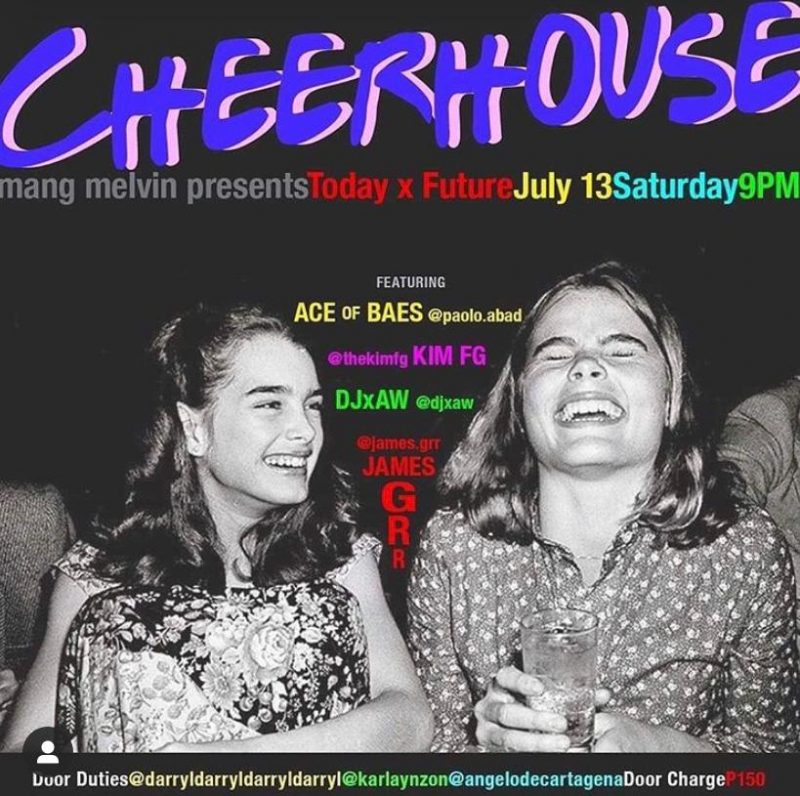
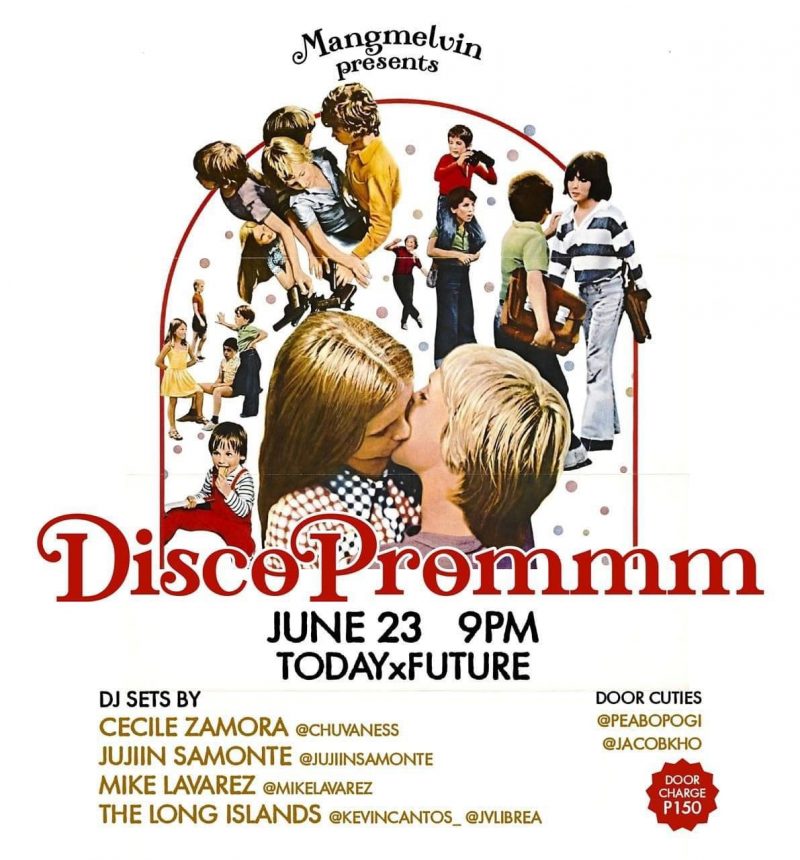
“These are some of the posters I made for TxF nights. The music, mood and memories of those nights stay with me until now. Lots of dancing, booze, hugs and besos. Future is not just a small cramped space, it’s a home for everyone.” – Nimu Muallam, Hinge creative director
“Looking back, the first time I went to TodayxFuture reads like a bad queer coming-of-age script (weirdly appropriate for TxF branding). All my friends’ plans for that night fell through and we found ourselves at TxF at 1 a.m. Long story short: A former fling-thing and their partner were there, and they had a huge fight. Friends and I split up to ease tensions between the two, and said fling-thing tried to kiss me. Her partner was less than 10 feet away. Ending? I ended up crashing for the night at the couple’s shared apartment.
Everyone, raise your glasses to TodayxFuture: the consistent backdrop to our messes. Thank you for being a safe space for us to navigate our clumsy queer experiences.” – Tricia Guevara, Preen.ph designer
“I was with my roommates on my last visit to TxF. At the time, a group of fabulous strangers were celebrating their friend’s birthday right next to our little huddle. They came up to us and offered a tray of shots that we could all take together, and we all had the best (albeit now blurry) night. I never felt unsafe in TxF. Everyone just felt like a friend immediately, and I could dance (sardinas-levels close) with anyone and everyone and have the best fun.” – Giselle Barrientos, Scoutmag.ph brand strategy lead
“Halloween is the best there. Every year people dress up as their favorite character or person. I went as Mimiyuuuh last year and so many people complimented me and asked for pictures with me. Besides the events, it’s one of the few safe spaces for LGBTQIA+ people in the metro, and for that I’m forever grateful for TxF.” – Anton Samaniego, Hinge junior digital associate
“People crowded around me while I danced aimlessly (others saw it as flailing violently) to a banger track. The hype that night was at a hundred and so was the chance of me breaking furniture. Yes, I ended up breaking a bottle.” – Levenspiel Sangalang, Nolisoli.ph junior designer
Header photo courtesy of Tammy David
Follow Preen on Facebook, Instagram, Twitter, YouTube, and Viber
Related Stories:
Celebrate Pride month with this screening of ‘Ang Huling Cha-Cha ni Anita’
Pride is always a protest, now is a good time to remember it
This local org is pushing for safe spaces for this year’s Pride Month
Read ’em and weep: The free, queer books that will prep you for Pride month
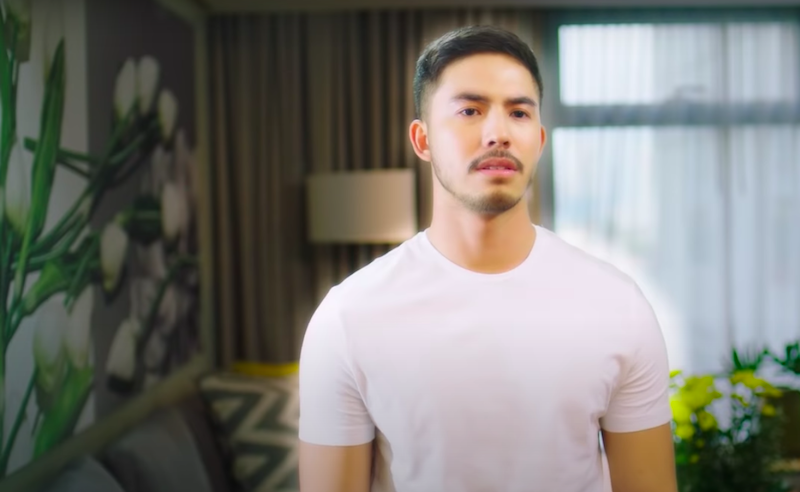
Let’s go, BL fans, let’s go! Black Sheep’s new digital BL series with Tony Labrusca just unveiled their title and the whole cast—and starring alongside Tony as his love interest is JC Alcantara. The poster for “Hello Stranger” was also revealed earlier today, with both men looking at their laptops and phones leaving us wondering what exactly they’re looking at.
I see you ??
Say hello to “Hello Stranger”, our first digital series starring Tony Labrusca and JC Alcantara, with Gillian Vicencio, Vivoree Esclito, Patrick Quiroz, and Miguel Almendras – coming to you real soon! ? #HelloStranger pic.twitter.com/5gHI1Ni6HX
— Black Sheep (@Black_SheepPH) June 16, 2020
The series also stars Gillian Vicencio, Vivoree Esclito, Patrick Quiroz and Miguel Almendras. We don’t have a set premiere date yet, but the teasers keep saying that it’s coming real soon so we’re refreshing like crazy.
The series is directed by Petersen Vargas who gave us the coming of age drama “2 Cool 2 Be 4gotten” and the first Filipino BL web series “Hanging Out.” His partnership with TEAM Mag for “Hanging Out” tackled the art drag, the difficulties of coming out and ransitioning as well as dealing with HIV—so you know, he isn’t playing when it comes to depicting LGBTQ+ struggles.
For now, while waiting for a teaser we can only speculate what kind of portrayal and representation Tony and JC will bring to a Filipino BL. Here’s hoping Tony’s is as funny as his portrayal of a buff and nearly always naked Jose Rizal in “Ang Babae Sa Septic Tank 3.”
Screengrab from “Hindi Tayo Pwede” official trailer
Follow Preen on Facebook, Instagram, Twitter, YouTube, and Viber
Related stories:
If you love ‘2gether,’ then you should binge-watch these BL shows too
Juan Miguel Severo pins down systemic homophobia as the enemy in casting queer actors
‘2gether’ might just be the cutest queer show on YouTube
‘Circus of Books’ Review: An acceptance v.s. tolerance family drama with gay porn history on the side
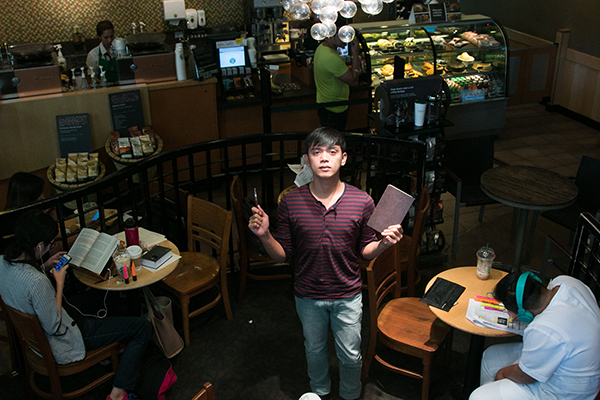
“Gaya Sa Pelikula,” the Boys’ Love (BL) series currently being developed by writer Juan Miguel Severo in partnership with Globe Studios, has now finished casting but Severo recently went on Twitter to air out the difficulty of looking for the actors perfect for playing the male leads.
In a Twitter thread posted yesterday, Severo says that since they started casting for the series, he’s been gaining a better understanding of why it has been difficult for the industry to cast queer actors for queer parts.
His thread cited various reasons why some productions opt to get straight actors for gay parts all boiling down to systemic homophobia. He explains that some queer actors veer away from playing queer characters because “they’re not ready to come out yet and taking on a gay role will inevitably subject them to convos about their sexuality.”
Nobody asked but since we started casting for Gaya, I gained better understanding of why, despite good intentions, some productions resort to casting straight actors for gay parts. Grabe, the paltry amount of experienced queer actors that went to audition was disappointing.
— Juan Miguel Severo ?️? (@TheRainBro) June 15, 2020
Typecasting is also another hurdle for queer actors—if they take on one gay role they might be reduced to playing token gay characters for the rest of their careers.
This understanding of how systemic homophobia works against queer actors in the media has prompted Severo and the team behind “Gaya’s” development to make adjustments to their casting call. Aside from asking audiences not to pry into the sexuality of the actors they will be casting, he also said “[i]n the end we decided not to specify in the casting call that we’re looking for queer actors, and let them decide whether they’re comfortable enough to disclose their SOGIE with us in the audition process.”
This is just one of the things that the production team has done to ensure that the upcoming series is a love story that the LGBTQ+ community deserves. The story itself includes Severo’s real-life experiences, so he and the team have made it their mission to put LGBTQ+ people at the forefront of the series’ development and production in a bid for responsible representation.
Severo also hopes to uplift the out and proud queer actors who may get casted. In the end, he says, that is what their series is working towards—for queer artists to gain opportunities and to be celebrated because of their queerness, not despite it.
While waiting for the premiere date of the love story between university students Karl and Vlad, you can get a sneak peek into the opening scene posted by the writer himself on Wattpad—yes, exactly like fanfic.
Photo by Alexis Corpuz from Inquirer Lifestyle
Follow Preen on Facebook, Instagram, Twitter, YouTube, and Viber
Related stories:
We’re #Still2gether: We’ll be seeing more of Tine and Sarawat soon
If you love ‘2gether,’ then you should binge-watch these BL shows too
Here are the essential feel-good WLW films worthy of a marathon
Celebrate Pride all year long with these local LGBT+ films
Pride Month comes at a difficult and somber time this year. In the middle of global social unrest because of human rights violations, a crackdown on freedom of speech and a worldwide health crisis, the LGBTQ+ community is faced with an opportunity to help out and pour the energy they use to celebrate and party at Pride into creating positive social change.
If you, a queer person, are finding it difficult to see the value of speaking out, fighting and protesting in order to secure human rights, it’s time to look back at Pride’s roots and see for yourself that we owe everything that we have now to the people who dared to stand up against tyranny, discrimination, police brutality and racism.
The Stonewall riots were borne out of years of continuous oppression. When police raided gay bar Stonewall Inn back in 1969, acts like dancing together, cross-dressing and even just holding hands were considered homosexual, and therefore illegal. Pioneers, like Storme Delarverie, Marsha P. Johnson and Sylvia Rivera, threw the first punches, bricks and shot glasses at the police who were arresting them and countless others. They didn’t just turn a blind eye to the obvious violation of human rights. Their efforts lead to a jumpstart in LGBTQ+ activism and eventually, to the rights we have now.
In the Philippines, the first Pride celebrations were protests that raised awareness on lesbian visibility, the destigmatization of AIDS and the call to stop harassment against gays and lesbians. In fact, the first recorded Pride March of the Philippines in 1994 coincided with a bigger protest against the Value Added Tax (VAT).
Things are definitely much better for the LGBTQ+ community these days. More countries are passing anti-discrimination and marriage equality laws. People are becoming more open-minded and educated in understanding the gender spectrum. We get to see ourselves represented in mass media. LGBTQ+ families even qualified for financial aid during the coronavirus pandemic.
But we cannot be caught relaxing. Just because our community is now experiencing a considerably better life than before, it doesn’t mean that we can now be silent. Mental disorders and substance abuse continue to be prevalent, with lower rates of treatment or support. Every year, more and more people lack access to quality healthcare, and the coronavirus pandemic is making it worse. People of color continue to be victims of targeted racism and homophobia. Heck, in our own country, we might be tagged as terrorists for simply expressing our opinion.
Pride is an avenue to protest and continue to fight for all these things. The good that we have now doesn’t even compare to what we still have to fight for. Knowing that its origins and our continuous fight for human rights are political, treating Pride as a mere celebration is absurd. Pride was, is, and always will be a protest. More than a celebration, Pride is an intersectional fight—that means it will not stop until everyone is treated equally. The struggle of the LGBTQ+ coexists and informs the struggle of other oppressed communities.
You cannot excuse yourself from movements like #BlackLivesMatter or #MeToo but actively participate in Pride, or vice versa. You cannot stand for women’s rights without recognizing trans women; you cannot protest the silencing of freedom of speech when you don’t believe in nonbinary gender expression; you can’t “eat the rich” but support brands profiting off rainbow capitalism.
June is Pride Month, but let’s not focus on the celebrations, especially with worldwide social unrest. We shouldn’t just be proud, we have to be angry, courageous and determined because all over the globe, human rights—and LGBTQ+ rights—are under threat. History shows that the only way we can rise is to fight back.
Photo by Mercedes Mehling on Unsplash
Follow Preen on Facebook, Instagram, Twitter, YouTube, and Viber
Related stories:
3 not-so-easy steps to make sure your involvement is not just performative
Read ’em and weep: The free, queer books that will prep you for Pride month
This local org is pushing for safe spaces for this year’s Pride Month
An open letter to the hypocrites on my feed
It’s five in the morning as of this writing. I have not slept a wink. And because it’s the beginning of Pride Month, I want to make this confession for only recently was I convinced that I did not sin:
I was 11 when I met Mia*. We were seatmates in fifth grade. We hit it off right away because we bonded over anime and growing boobs since we were two of the first girls who started wearing baby bras, which in a Filipino public school setting was quite controversial, of course. Having just transferred from a private Catholic school, I was the quieter one while Mia was more outspoken, headstrong and streetwise. She cussed a lot and knew how to trash talk with our male classmates. Naturally, I admired and respected her.
We started cutting classes to play by the school’s neglected fishpond, first with other friends, and then later by ourselves. This was when I got to know the deeper, more personal side of Mia underneath the tough façade. I didn’t have anyone to talk to about all the stuff we talked about: puppy love, menstruation, why boys liked big boobs, ghosts, fairies and other mythical creatures that we were 99 percent positive were real, and then always back to puppy love.
I discovered how she liked boys a lot, especially those with “butterfly” haircuts (curtain or “kachupoy” style) made popular by Leonardo DiCaprio in the 90s. She was into pocketbooks (romance novels) and couldn’t wait to have a boyfriend. Mia was also awfully caring towards me and answered all my questions. Before I knew it, my only desire was to make her happy.
I was pretty good at drawing anime. Mia loved it! Eventually, all I drew were her requests. We wrote this fictional story about two schoolgirls falling in love with older guys who existed in a parallel universe—yes, we watched too much “Fushigi Yuugi.” It was the shit back then aside from “Pokémon!” I drew all the characters and scenes.
I still remember quite vividly how she smelled: intoxicatingly warm and sweet.
One lazy afternoon, while the teacher was sleeping and the class was preoccupied with its usual lively chaos, I was drawing a kissing scene between two of the characters under Mia’s close supervision. We caught each other’s eye and she whispered to me, “Can you pretend to be my boyfriend?” I was taken aback, nervous but strangely excited. I couldn’t understand what I was feeling.
I followed her into the restroom—each of our classrooms had one inside—and there, we shared a French kiss like how we’d imagined it. I do not know if I was her first, but she was mine.
We had shared many kisses and so much more during those secret trysts in the restroom. We made sure to enter and leave as fast as we could so nobody else would know. Up to now, I still wonder if anybody noticed. Mia, especially, was very careful. At recess time, it was understood that I accompanied her wherever she went, held her hand like a dutiful boyfriend, hugged her when she asked me to.
I also acquired this tendency to be highly protective of her. I once marched up to our male music teacher who was making inappropriate moves on her and said, “Manyak!” under my breath. Enraged, he yelled, “What did you say?!” and tried to grab me. But I managed to run away, frightened and victorious at the same time. We were known to be “best friends,” so I guess no one suspected otherwise.
One day, I invited her for lunch at home. We fell asleep in my bed for about an hour with my arms around her. I still remember quite vividly how she smelled: intoxicatingly warm and sweet. That afternoon, my father confronted me, “Is Mia your girlfriend?” I was dumbfounded. Apparently, he saw us huddled asleep earlier. “What? No! We’re just friends,” I said before storming off to my room. I couldn’t even lock the door because I didn’t have a door back then. At that point, a deep gut-wrenching feeling of fear and shame took over me. I wanted to cry, but I knew I had to keep my cool, lest my father wanted to interrogate me more.
I was barely familiar with lesbians at that time. We had a female classmate who was being wooed by a female sixth grader who dressed and acted like a guy. I didn’t know that I could be a lesbian even if I wasn’t particularly attracted to the sixth grader. I was attracted to feminine girls. Like Mia.
My earliest memory of liking girls was when I was ten. My mother collected women’s magazines and one issue had a young Angelina Jolie on the cover. She was the most beautiful thing I’d ever seen! I would often kiss her like how my Lola would kiss an image of the Virgin Mary.
My aunt caught me once. She pulled me aside violently and screamed at me, “What are you doing? Girls are for boys! Boys are for girls! Do you not know what happens to those liking their own kind? THEY GO TO HELL!” before slapping both of my hands. I guess that was where my fear and shame originated, because for sure, children are not born with those feelings, right? But when I went to school and spent time with Mia, I’d forget those ugly feelings. I was content and happy, even if it was just a game of pretend for her.
After my failure to secure a spot in the class top ten for the first time, my mother became more stringent with me. She considered Mia a “bad influence,” which actually had some truth in it because all I did was draw for her and cut classes with her. I was crazy about her. My mother made sure that I didn’t spend any more hours in school after classes by hiring my uncle as transportation service. I think she spoke with our class adviser in private, too, because all of a sudden, there were strict rules regarding swift restroom use.
I was devastated. I felt like I was being chased, cornered. Fear and shame resurfaced in the depths of my gut until I felt sick about getting caught with Mia, like I would throw up.
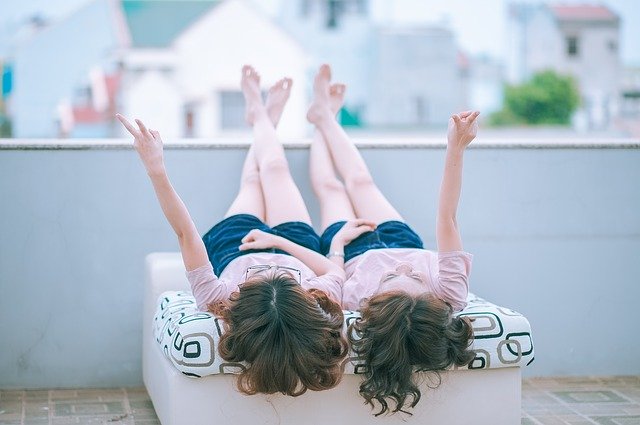
Image by Jess Foami from Pixabay
Mia must have noticed my aversion to her because by sixth grade, she did not sit next to me anymore. The last time I remembered holding her was when she was crying over being rejected by her male crush due to her developing prepubescent body odor. I hugged her, assuring her that it was okay. “I’m still here,” I told her softly. She pushed me and said, “You’re not a real boy!” Man, that broke me.
We never said a word to each other since until graduation day. To my mother’s delight, I went up the stage in a pink frilly dress and was awarded six medals. After the ceremonies, Mia approached me and pointed to the medals around my neck, “Must be heavy!” She was smiling. I smiled back but couldn’t bring myself to say anything. I froze until another female friend (platonic) pulled my arm and insisted on introducing me to her mother. Mia said, “Go on, don’t mind me.” And that was the last time I saw her for years.
In high school, I never thought of her. Girls pretty much disgusted me except for my Earth Science teacher whom I found to be extremely attractive. I only had one male crush and never acted on it. In fourth year, a close male friend asked me if he could court me and I said, shrugging, “Sure, I’ll be your girlfriend” like it was nothing. High school was soooooo weird.
College, on the other hand, was better. I saw more types of girls and was fascinated by them anew, with how they looked, what they wore, how they maintained such clean feet even while wearing flip flops around the campus. I began to think of Mia again. I messaged her online a few times but she never replied.
One time, I was learning my way around Friendster or Facebook, I don’t remember, when I stumbled on her profile. She was an out lesbian and she had a butch girlfriend. They posted a lot of sexy poses together. I was beyond shocked because I thought she was into boys.
After college, before deciding to live with a guy, I had another crisis: I was falling for a female colleague. One night, I didn’t sleep and took the bus on a whim to a town outside the city. Just to think. Fear and shame were crippling and paralyzing me again. Guess who I tried to message? Mia.
This time, she replied. But I never mentioned anything about her sexual orientation, although I was itching, dying, to ask her about it. I wanted to see her wherever she was in Manila. I wanted to kiss her again and sleep with her in my arms. But as soon as our conversation starter on anime ended, she never responded to my “Can we meet?”
Long story short, the female colleague I was falling for happened to be as straight as a pole and I ended up in a relationship with this guy for about five years which then led to my giving birth to a beautiful daughter. Unfortunately, he died of an accident before I even delivered the baby. I had everything figured out with him. In a single moment, my world came crashing down. In a single crashing moment, I was widowed before 30.
Mia will always fill a special void in my heart, the preadolescent void that never quite grew up because it was too scared of ugly feelings.
I loved him truly and grieved for a long time without dating anyone, two years to be exact. One April day this year, whilst on lockdown (could very well be the pandemic hormones, I must admit), I woke up with my heart feeling a lot more open to other people. I could have messaged any of my male exes, but I thought only of her. I sent a hopeful greeting to Mia disguised with the nonchalance of “Hey.” She replied. We talked for hours.
Out of the blue, I noticed a change in her last name. I wondered why I didn’t notice it earlier. This prompted me to check her profile: Mia just got f*cking married to a guy! I tried to hide my shock, disappointment and utter sadness by saying, “Hey! You got married! You didn’t say! Congratulations!”
“I’m actually in the hospital right now, I’m expecting to deliver any time soon,” she answered. Mia was going to be a mother, too! As if on impulse, all my negative emotions vanished and were replaced with genuine happiness for her.
I gave her all the tips I could give as a first-time mother myself. I was both laughing and crying while messaging her. Before we said goodbye on the chat app, I knew I had to say it: “I’ve always wanted to tell you but never had the courage to. You will always be my first love.”
I was so nervous typing it and even more nervous while waiting for her response. After a few minutes, she replied, “Same here. You know that.” Needless to say, I ugly cried myself to sleep.
At present, we exchange messages occasionally about breastfeeding and infant care like any normal pair of new mothers, like the best friends we were. I began to answer some DMs from guys and even started a Bumble account. However, Mia will always fill a special void in my heart, the preadolescent void that never quite grew up because it was too scared of ugly feelings.
Sometimes, I find myself looking at my daughter and thinking, “If one day, she realizes that she likes girls in school, I swear I’ll understand her, encourage and protect her at all costs. I will never teach her fear or shame. Only love and pride. After all, children are not born with these feelings. They are taught and internalized until they become life itself.
Mia was not “a phase” as most homophobic conservatives would put it. I know for a fact that I was in love with her for decades while also being romantically involved with men. But there are days when I wonder, “What if I fought for her? What if I was never afraid or ashamed of loving fellow women?” But hey, it’s not too late. I’m alive, I still have time. And just like the wide-eyed eleven-year-old anime-drawing me, I am both nervous and thrilled about so many possibilities! Only this time, no more pretending. A liberating Pride Month, everyone! I wish you strength and courage to last you all your life to love as freely as humanly possible.
*Not her real name
Photo courtesy of Javier Lobregat from our coverage of Pride 2019
Follow Preen on Facebook, Instagram, Twitter, YouTube, and Viber
Related stories:
Connect with your queer family with this open letter initiative
Underrated queer shows to stream during the lockdown
Faces of Pride: Effy Elmubarak reminds us of the place of intersectionality in Pride
Faces of Pride: Artist Isola Rosa wants to fight for the marginalized

